It was named LiFi technology
Li-Fi is wireless technologies that are mentioned will replace the Wi-Fi network. Li-Fi itself using technology based on light (Visible Light Communication / VLC) to mentransmisi data flow. Different with Wi-Fi is thus using radio waves for downloading the transmission of the data flow.
Li-Fi (Light Fidelity) is a new method for sending data packet wireless-based high speed that use visible light spectrum (visible light spectrum), which LED light bulb. Now the reasons for using the LED light bulb because Li-Fi technology provide lighting with a very high level which is LED semiconductor light source that can strengthen the intensity of the light and the movement is so fast to modulate the thousands of signals that are not seen by man. With the use of this Li-Fi technology can provide internet access 100 times faster compared with Wi-Fi. Li-Fi have data transfer speed up to 1Gbps (Giga bits per second). This is far more rapidly than the Wi-Fi only 600Mbps
Recently, Li-Fi technology has been tested by the new company stands in Estonia named Velmenni. They did an experiment for this technology in some of the office and laboratory and industrial environments in the city of Tallin (the capital city of Estonia). From the result of the experiment were obtained that data speed theoretically by 224 Gbps. That means a high resolution movies will later be downloaded only in seconds.
Of course the community is not in a hurry to immediately use this Li-Fi technology that will replace the Wi-Fi technology. Speaking about the readiness of this technology, Deepak Solanki (CEO Velmenni) stated that we are doing a pilot project in a number of different industry where we can use technology VLC (Visible Light Communication). When we have been designing lighting solutions that smartphone for industrial environments where data communication is done through the light. We also conducted a pilot project with personal client where we are preparing Li-Fi network to access the internet at our office space. This new technology can be enjoyed by consumers on 3-4 years. This technology has also been tested by the participating airlines want to use it to provide better connectivity in the flight and the intelligence agencies are interested in the potential Li-Fi security to the wireless data transfer. Before Velmenni, there are already some companies doing research to this Li-Fi technology. In April 2014, the company Russia Stins Coman develop wireless technology Li-Fi given name BeamCaster. The results of their research shows data transfer speed range 1.25 Gbps. But they estimate can increase the speed up to 5Gbps in the near future. The company Mexico named Sisoft has break a new record in the year 2014 with produce data transfer speed up to 10 Gbps through the spectrum of the light of the LED light. It is expected that research in the following years can produce data transfer speed is better than the previous research.
Who is the idea behind the discovery of this advanced?
In 2011, Li-Fi technology created by Prof Harald Haas a German nationals physicists from the University of Edinburgh, Scotland which also serves as the Chairman of the Mobile Communication. In addition, Prof. Haas is a co-founder of PureLifi. Prof. Haas explained about the future where billions of the bulb later can become a wireless hotspot. In his presentation at the conference TED (Technology Entertainment and Design) in 2011, Prof. Haas describes technology using VLC speed LED modern reach 1000Gbps while if using infra red only around 1000 bps only. This means that the speed at which is produced from the LED light spectrum 10,000 times larger than the spectrum of radio waves. Prof. Haas also said that the infrastructure when it is possible for each light bulb single LED light is changed to a wireless router super fast. According to him that needs to be done is to adjust the small microchip for each device potential lighting. This will combine two basic function of the lighting and wireless data transmission
Li-Fi technology have superiority does not interfere with other radio signal so that it is possible to be used in the aircraft and other places affected by the use of radio signal. Other advantages that light cannot penetrate the wall so that it makes it more secure from snooping by external parties. But it also has a shortage of Li-Fi, namely cannot be used outside of the pool under the direct sunlight, because the transmission of information by lighting the light through the air become more difficult. This is due to the lack of tunnel lighting that can guide the direction of the signal while in nature.
How Li-Fi work?
The picture above is how Li-Fi technology work in a pool. Data such as audio, video, web and application information sent from the server on the local network or internet in binary form. This is commonly called streaming. Before the data is forwarded to the LED light, there is a component of the lamps drivers as controller which consists of:
(PCB Printed Circuit Board), assigned to control the input and output power from the light and mikrokontroler house that is used to manage the function of different light.
PAC (Power Amplifier Circuit), assigned to produce radio frequency signals that guide the flow of data to the electric field around the bulb.
Bulb, a light bulb that embedded materials dielectric latch up free structures to guide the waves radio frequency energy emitted by the PAC and as material for the concentrator electric field that focuses on the energy that is in the bulb.
The enclosure is aluminum poles box that protects the PCB, PAC, and Bulb in one packaging. Aluminum is introduction electricity is good and light for the use of remote electric transmission.
When the Bulb emits a constant current to the LED light bulb with a very high speed, a constant stream of photons emitted from the light observed as a VLC. To detect the flow of data on the intensity of the high speed required a component of the air photos (photo detector). This component is also working to change the data flow in the intensity of light (amplitudo) signal to the mains. Amplification and signal processing Unit (amplification and signal processing) task change the flow of data in binary form into the original data such as audio, video, web application information and then transmitted to the computer or mobile device. The function of the air photos and signal processing is packed in a device that is called receiver doungle. A computer must have the infrared LED to be able to communicate in the uplink channel
What Li-Fi technology challenges to the future?
This Li-Fi technology still need further research to proportion. The current challenge how to develop this Li-Fi technology optimally in order to be used in the home and work environment with a relatively cheaper cost. As we already know that the intensity of the light good depends on the power (Watts) lamp. The higher the light power, then will produce the intensity of the light. That means that the cost is relatively expensive to adjust the light prices based on power. Moreover this technology does not include the massive area, but cannot penetrate the wall so that need a lot of light power and other Li-Fi components in a corner of the room or building that can be connected to each other and have the optimal speed that stable.
For the next challenge, how Li-Fi technology can be accessed outside the house at the time of the morning ahead of the afternoon where there is still sunlight as spoilers or obstructions a flow of data that is sent in order to destination address with perfect. Until this time, Li-Fi technology has not been able to support this.
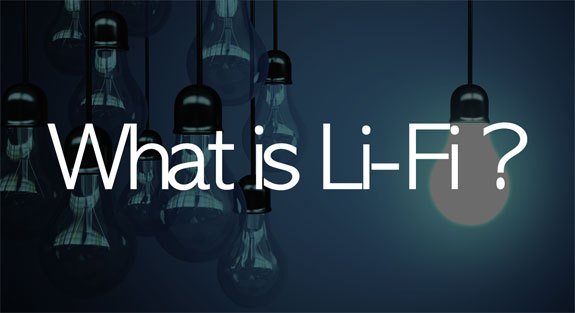
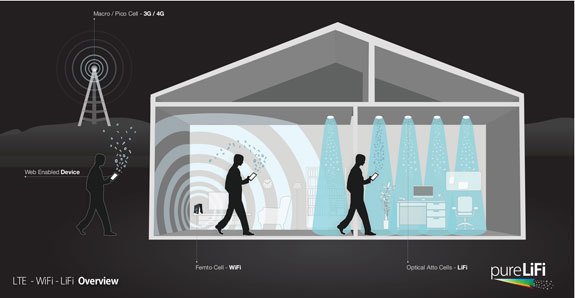
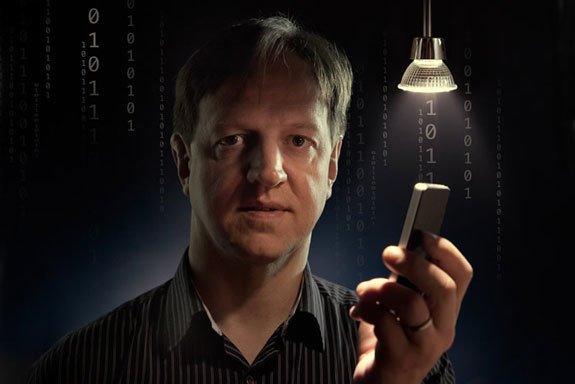
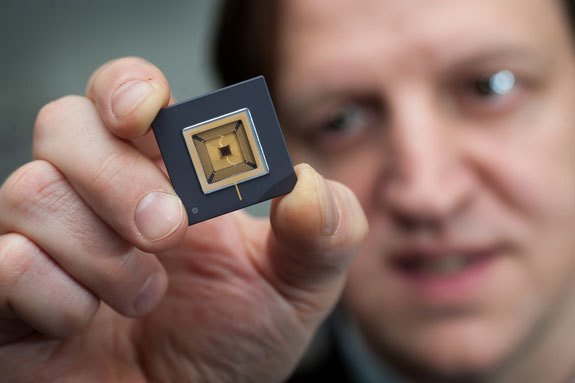
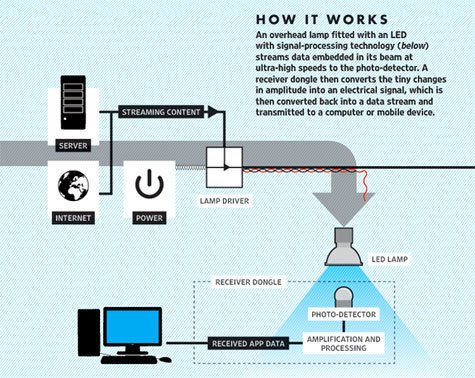
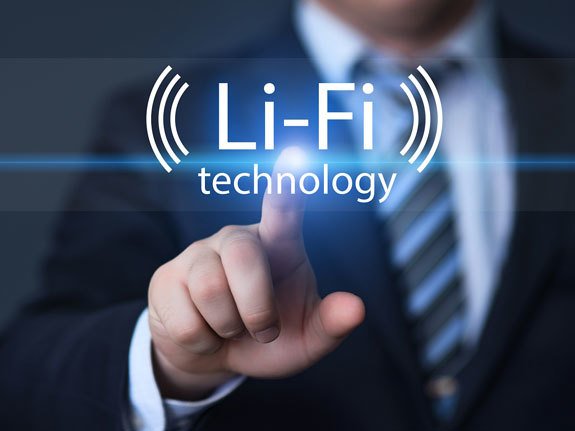
Great concept, but I think the internet is the wrong application. Maybe the internet of things. I think of night time driving.
Li-FI apkah sama dg wi-fi :D
bagusan LiFi